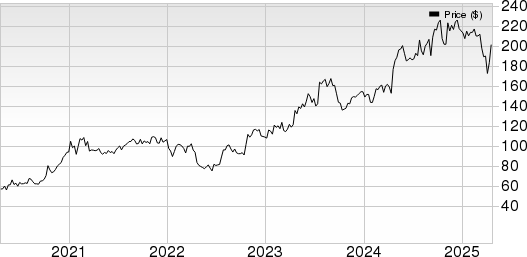Advanced Micro Devices Stock: High Valuation Raises Concerns
Advanced Micro Devices (NASDAQ:AMD) Stock is currently priced at approximately $93, raising concerns about its valuation. Given its relatively high market price, there are minor worries surrounding AMD’s financial status that could make it an expensive buying option at this time.
The surge in demand for GPUs driven by the generative AI trend has not translated into equivalent gains for AMD’s AI accelerator segment, which has lagged behind expectations. For the fourth quarter, AMD reported data center revenue—viewed as a benchmark for AI chip sales—of $3.9 billion, which was below analysts’ expectations. The company has also forecasted a weak upcoming quarter, anticipating a 7% decline in data center revenue. Additionally, President Donald Trump’s trade policies could pose risks for AMD. The unclear impact of tariffs on semiconductor imports, combined with inconsistent messaging from the White House, might negatively affect AMD since it sources many of its chips from Taiwan and other Asian regions. Compounding this challenge is AMD’s lower gross margins compared to competitors like Nvidia, which leaves it with less leeway to absorb tariff costs.

Image by foto qin from Pixabay
Examining key indicators like Growth, Profitability, Financial Stability, and Downturn Resilience shows that while Advanced Micro Devices has maintained a strong operating performance and financial health, its overall valuation remains high. For investors looking to minimize volatility while seeking returns, the Trefis High-Quality portfolio offers an alternative, having outperformed the S&P 500 and generated returns over 91% since its launch.
AMD Valuation Compared to the S&P 500
When assessing AMD’s price relative to sales and profits, it’s evident that AMD Stock appears quite expensive in comparison to the broader market.
• Advanced Micro Devices has a price-to-sales (P/S) ratio of 5.6, significantly higher than 2.8 for the S&P 500.
• Furthermore, AMD’s price-to-operating income (P/EBIT) ratio stands at 69.0, compared to 21.3 for the S&P 500.
• Lastly, the company’s price-to-earnings (P/E) ratio is 87.7, notably higher than the benchmark’s 21.3.
Revenue Growth at Advanced Micro Devices
AMD has experienced substantial revenue growth in recent years.
• The company achieved an average revenue growth rate of 17.8% over the past three years, contrasting with the S&P 500’s 6.2% increase.
• In the past year, its revenues rose by 13.7%, from $23 billion to $26 billion, outperforming the S&P 500’s 5.3% growth.
• Moreover, AMD saw a quarterly revenue increase of 24.2%, reaching $7.7 billion in the latest quarter, up from $6.2 billion a year prior, while the S&P 500 improved by just 4.9%.
Profitability of Advanced Micro Devices
Despite its growth, AMD’s profit margins remain lower than the average of its peers.
• Over the last four quarters, AMD’s operating income was $2.1 billion, which translates to a disappointing operating margin of 8.1%, while the S&P 500 average is 13.1%.
• Its operating cash flow (OCF) during this timeframe reached $3.0 billion, yielding a moderate OCF-to-sales ratio of 11.8%, compared to the S&P 500’s 15.7%.
Financial Stability of Advanced Micro Devices
A glance at AMD’s balance sheet reflects a strong financial condition.
• As of the latest quarter, AMD had $2.2 billion in debt, with a market capitalization of $152 billion (as of 4/11/2025). This results in an impressive debt-to-equity ratio of 1.5%, significantly less than the S&P 500’s 21.5%. [Note: A lower debt-to-equity ratio is considered favorable]
• Cash and cash equivalents account for $5.1 billion of AMD’s total assets of $69 billion, which leads to a moderate cash-to-assets ratio of 7.4% against the S&P 500’s 15.0%.
Stability of AMD Stock During Market Downturns
Historically, AMD has encountered more significant declines than the S&P 500 during recent downturns. Concerned about potential market crashes affecting AMD Stock? Our dashboard, “How Low Can Advanced Micro Devices Stock Go In A Market Crash?” provides an in-depth analysis of the stock’s performance during previous downturns.
Inflation Shock (2022)
• AMD Stock plummeted by 65.4%, from a peak of $161.91 on November 29, 2021, to $55.94 on October 14, 2022, compared to a peak-to-trough decline of 25.4% for the S&P 500.
• The Stock recovered fully to its pre-crisis peak by January 18, 2024.
• Since then, the share price has risen to a high of $211.38 on March 7, 2024, but currently trades around $93.
Covid Pandemic (2020)
• AMD Stock declined by 34.3%, dropping from $58.90 on February 19, 2020, to $38.71 on March 16, 2020, relative to a peak-to-trough decline of 33.9% for the S&P 500.
• The Stock fully recovered to its previous peak by July 22, 2020.
Global Financial Crisis (2008)
• AMD Stock experienced a staggering decline of 91.2%, from $20.35 on January 1, 2007, to $1.80 by November 25, 2008, compared to a peak-to-trough drop of 56.8% in the S&P 500.
• The Stock regained its pre-crisis level by August 21, 2018.
Conclusion: Analyzing AMD Stock’s Future
In summary, AMD’s performance metrics yield the following insights:
- Growth: Extremely Strong
- Profitability: Weak
- Financial Stability: Very Strong
- Downturn Resilience: Very Weak
- Overall: Neutral
However, considering its elevated valuation, it appears that AMD Stock is expensive to buy at this moment.
The high valuation of AMD Stock restricts its potential growth in the near term. An alternative to consider is the Trefis Reinforced Value (RV) Portfolio, which has surpassed its all-cap stock benchmarks—integrating the S&P 500, S&P Mid-Cap, and Russell 2000 indices—yielding solid returns for its investors. This portfolio’s quarterly rebalanced approach allows it to capitalize on favorable market conditions while limiting losses during downturns, as shown in the RV Portfolio’s performance metrics.
Invest with Trefis Market-Beating Portfolios
see all Trefis Price Estimates
The views and opinions expressed herein are the views and opinions of the author and do not necessarily reflect those of Nasdaq, Inc.


